
A firearm is any type of gun that uses an explosive charge and is designed to be readily carried and operated by an individual. The term is legally defined further in different countries.
Gun laws and policies, collectively referred to as firearms regulation or gun control, regulate the manufacture, sale, transfer, possession, modification, and use of small arms by civilians. Laws of some countries may afford civilians a right to keep and bear arms, and have more liberal gun laws than neighboring jurisdictions. Gun control typically restricts access to certain categories of firearms and limits the categories of persons who may be granted permission to access firearms. There may be separate licenses for hunting, sport shooting, self-defense, collecting, and concealed carry, each with different sets of requirements, privileges, and responsibilities.
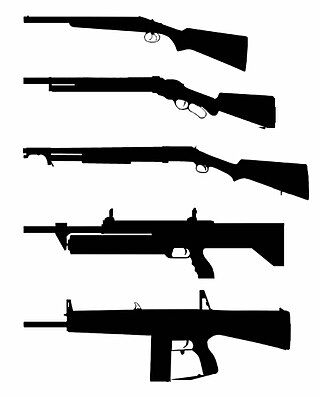
A shotgun is a long-barreled firearm designed to shoot a straight-walled cartridge known as a shotshell, which discharges numerous small spherical projectiles called shot, or a single solid projectile called a slug. Shotguns are most commonly used as smoothbore firearms, meaning that their gun barrels have no rifling on the inner wall, but rifled barrels for shooting sabot slugs are also available.
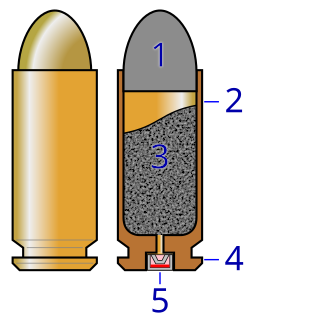
A cartridge, also known as a round, is a type of pre-assembled firearm ammunition packaging a projectile, a propellant substance and an ignition device (primer) within a metallic, paper, or plastic case that is precisely made to fit within the barrel chamber of a breechloading gun, for convenient transportation and handling during shooting. Although in popular usage the term "bullet" is often used to refer to a complete cartridge, the correct usage only refers to the projectile.
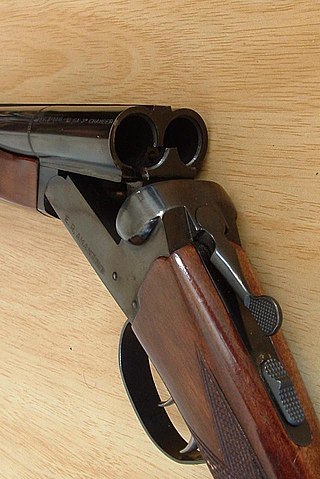
In firearms terminology, an action is the functional mechanism of a breech-loading firearm that handles the ammunition cartridges, or the method by which that mechanism works. Actions are technically not present on muzzleloaders, as all those are single-shot firearms with a closed off breech with the powder and projectile manually loaded from the muzzle. Instead, the muzzleloader ignition mechanism is referred to as the lock.
Firearms in Canada are federally regulated through the Firearms Act, the Criminal Code, and the Canadian Firearms Program, a program operated within the RCMP. Regulation is largely about licensing and registration of firearms, including air guns with a muzzle velocity of more than 500 ft/s or 150 m/s and muzzle energy greater than 4.2 ft⋅lb or 5.7 J.
In the United Kingdom, access by the general public to firearms is subject to strict control measures. Members of the public may own rifles and shotguns, however, they must be properly licensed. Most handguns have been banned in Great Britain since the Dunblane school massacre in 1996. Handguns are permitted in Northern Ireland, the Channel Islands, and the Isle of Man which have their own applicable laws. Scotland imposes its own additional licensing requirements for airguns.
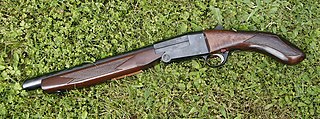
A sawed-off shotgun is a type of shotgun with a shorter gun barrel—typically under 18 inches (46 cm)—and often a pistol grip instead of a longer shoulder stock. Despite the colloquial term, barrels do not, strictly speaking, have to be shortened with a saw. Barrels can be manufactured at shorter lengths as an alternative to traditional, longer barrels. This makes them easier to transport and conceal due to their smaller profile and lighter weight. The design also makes the weapon more portable when maneuvering in confined spaces and for that reason law enforcement and military personnel find it useful in close-quarters combat scenarios. As a result of the shorter barrel length, any shotgun with a tubular magazine will have a reduction in its magazine capacity.
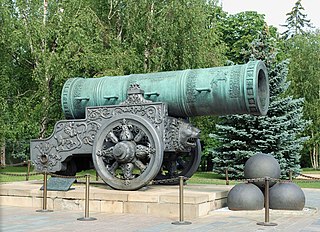
A gun barrel is a crucial part of gun-type weapons such as small firearms, artillery pieces, and air guns. It is the straight shooting tube, usually made of rigid high-strength metal, through which a contained rapid expansion of high-pressure gas(es) is used to propel a projectile out of the front end (muzzle) at a high velocity. The hollow interior of the barrel is called the bore, and the diameter of the bore is called its caliber, usually measured in inches or millimetres.

The Firearms (Amendment) Act 1997 was the second of two Acts of the Parliament of the United Kingdom from 1997 that amended the regulation of firearms within Great Britain. It was introduced by the newly elected Labour government of Tony Blair. The first Act was the Firearms (Amendment) Act 1997.
A powerhead is a specialized firearm used underwater that is fired when in direct contact with the target. Powerheads are often used for spear fishing and against sharks or alligators for sport, defense, or to kill nuisance animals. The term powerhead refers to the firearm-like part of the device; when attached to a shaft to form a spear, it may be referred to as a bang stick or shark stick. The spear in question may be handheld or launchable from a spear gun.

In breechloading firearms, an extractor is an action component that serves to remove spent casings of previously fired cartridges from the chamber, in order to vacate the chamber for loading a fresh round of ammunition.

Break action is a type of firearm action in which the barrel(s) are hinged much like a door and rotate perpendicularly to the bore axis to expose the breech and allow loading and unloading of cartridges. A separate operation may be required for the cocking of a hammer to fire the new round. There are many types of break-action firearms; break actions are universal in double-barreled shotguns, double-barreled rifles, combination guns, and are commonly found in single shot pistols, rifles, shotguns, including flare guns, grenade launchers, air guns, and some older revolver designs. They are also known as hinge-action, break-open, break-barrel, break-top, or, on old revolvers, top-break actions.

An antique firearm is a term used to describe a firearm that was designed and manufactured prior to the beginning of the 20th century. Although the exact definition of what constitutes an "antique firearm" varies between countries, the advent of smokeless powder or the start of the Boer War are often used as cut-off dates. Antique firearms are usually collected because of their historical interest and/or their monetary value.
The following are terms related to firearms and ammunition topics.

Title II weapons, or NFA firearms, are designations of certain weapons under the United States National Firearms Act (NFA).
The gun laws of New Zealand are contained in the Arms Act 1983 statute, which includes multiple amendments including those that were passed subsequent to the 1990 Aramoana massacre and the 2019 Christchurch mosque shootings.

The Firearms (Amendment) Act 1988 is an Act of the Parliament of the United Kingdom, which is still in force. The Act, as amended, tightens controls on the possession of firearms, and applies throughout the whole of the United Kingdom except for Northern Ireland. On 15 November 1988, the Act gained royal assent. The Act was partly in force at royal assent. On 1 February 1989, fourteen sections of the first 25 sections of the Act came into force. On 2 April 1991, the Act came wholly into force.
Irish law allows firearm possession on may-issue basis and the general public's access to firearms in the Republic of Ireland is subject to strict control measures that rank among the strictest globally. With approximately seven civilian firearms per 100 people, Ireland is the 107th most armed country in the world.

The Arms Amendment Act 2019 is an act of the New Zealand Parliament that amends the Arms Act 1983 to ban semi-automatic firearms, large capacity magazines, and parts that can be used to assemble prohibited firearms. It was introduced by Labour Cabinet Minister and Member of Parliament Stuart Nash in response to the Christchurch mosque shootings. The Bill passed its third and final reading on 10 April 2019, receiving royal assent the following day. The Arms Amendment Bill was supported by all parties represented in Parliament except the opposition ACT Party.











